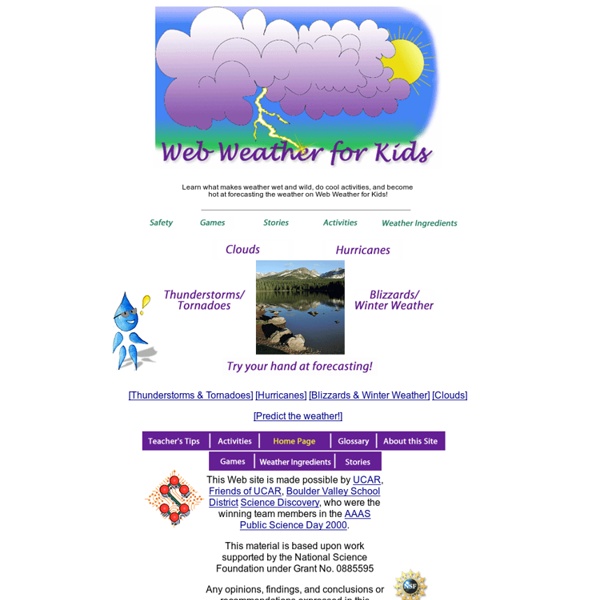



http://eo.ucar.edu/webweather/
Related: Extreme WeatherYoung Meteorologist We’ve gathered extensive links to digital resources designed to help everyone learn the science of weather, help educators reinforce their own content knowledge, and get kids engaged in science that affects us all each and every day. Weather Basics Weather Glossary The Weather Channel defines more than 800 weather-related terms. Web Weather for Kids Weather Glossary Kid-friendly definitions for basic weather vocabulary. Welcome - Southeast Regional Climate Center Welcome to Climate Kids - where kids of all ages can have FUN learning about our climate! Click the image below for Games, Activities, and Resources or scroll down for our text menu.
Severe Weather 101 Step into the wild world of weather! What is a wall cloud? What's the difference between a watch and a warning? Is it ever “too cold to snow”? Learn all about thunderstorms, tornadoes, hail, lightning, floods, damaging winds and severe winter weather. Thunderstorms Weather Wiz Kids weather information for kids Winter StormsHow do winter storms form?Winter storms derive their energy from the clash of two air masses of different temperatures and moisture levels. Winter storms usually form when an air mass of cold, dry, Canadian air moves south and interacts with a warm, moist air mass moving north from the Gulf of Mexico. The point where these two air masses meet is called a front.
Climate Change How is the climate changing in the U.S.? Observations across the United States and world provide multiple, independent lines of evidence that climate change is happening now. Learn More What are climate change and global warming? Tornado Central - weather.com US Severe Weather Alerts Prominent severe weather alerts issued by the National Weather Service now viewing Current US Doppler Radar Map Current US Surface Weather Map Current US Infrared Satellite Map
What Causes a Blizzard? Heavy snow, bitter cold, whipping winds … Winter storms are no picnic, but what is the official definition of a blizzard, and what causes them, anyway? The National Weather Service defines a blizzard as any severe snowstorm that is accompanied by strong winds — at least 35 mph — resulting in low visibility. The defining factor of a blizzard is actually the strength of the wind, rather than the amount of snow. To qualify as a blizzard, the combination of wind and snow must reduce visibility to a quarter mile or less and last for at least three hours. Severe blizzards can reduce visibility to zero, making it difficult to see buildings or trees just a few yards away. While blizzards often feature extreme cold and heavy snow, there are actually no temperature or snow depth requirements for a storm to qualify as a blizzard.
Damaging Air Winds: Kids Guide to Tornadoes Authored by Dr. Jeff Bennert Windy days can really stir things up and make it difficult to hold on to things that are important, like your umbrella or paper from school. Wind can also be pretty scary too, especially when that wind is a tornado. Known as twisters, tornadoes can tear down a house and can really hurt or even kill people who are in its path. An air purifier or air ionizer can be helpful when people have to seek shelter from tornadoes in basements or in areas that are underground and safe.